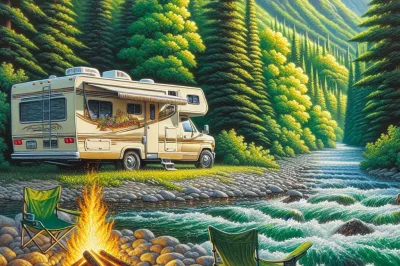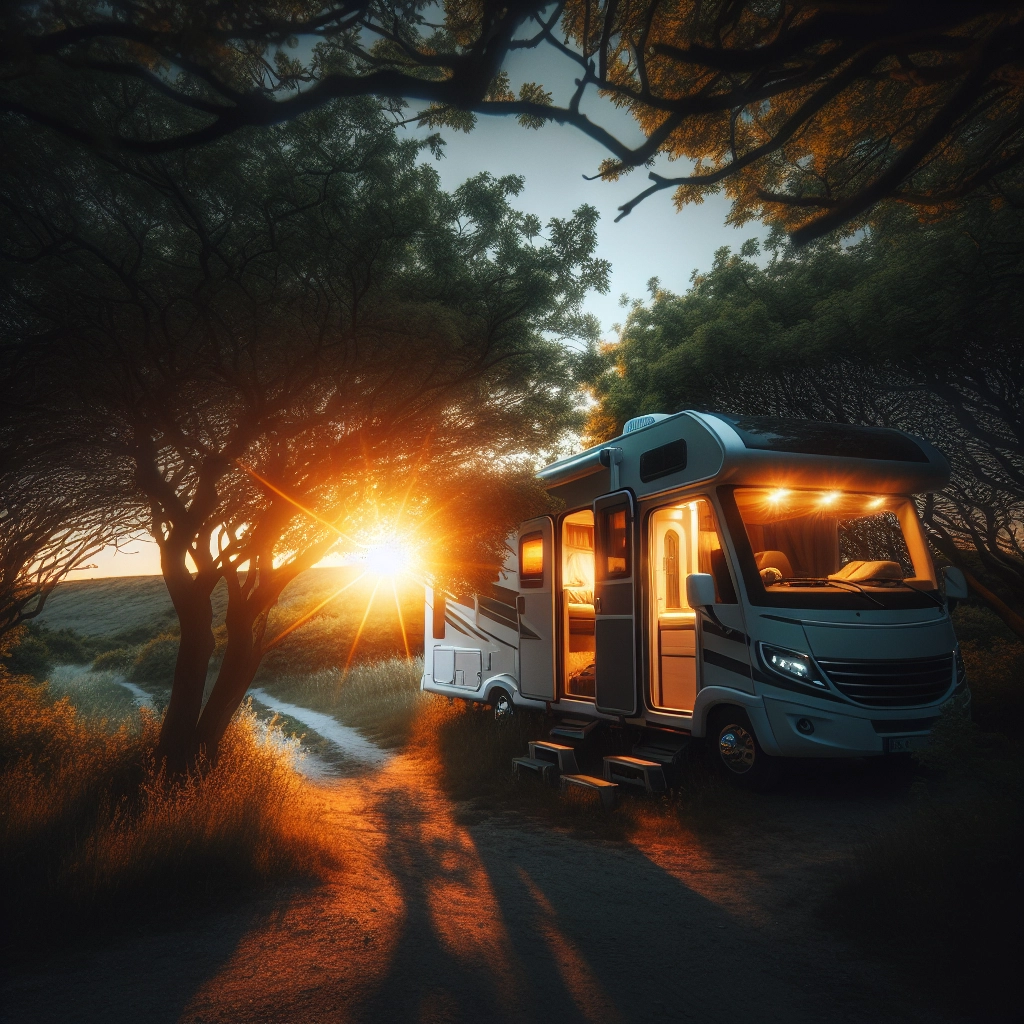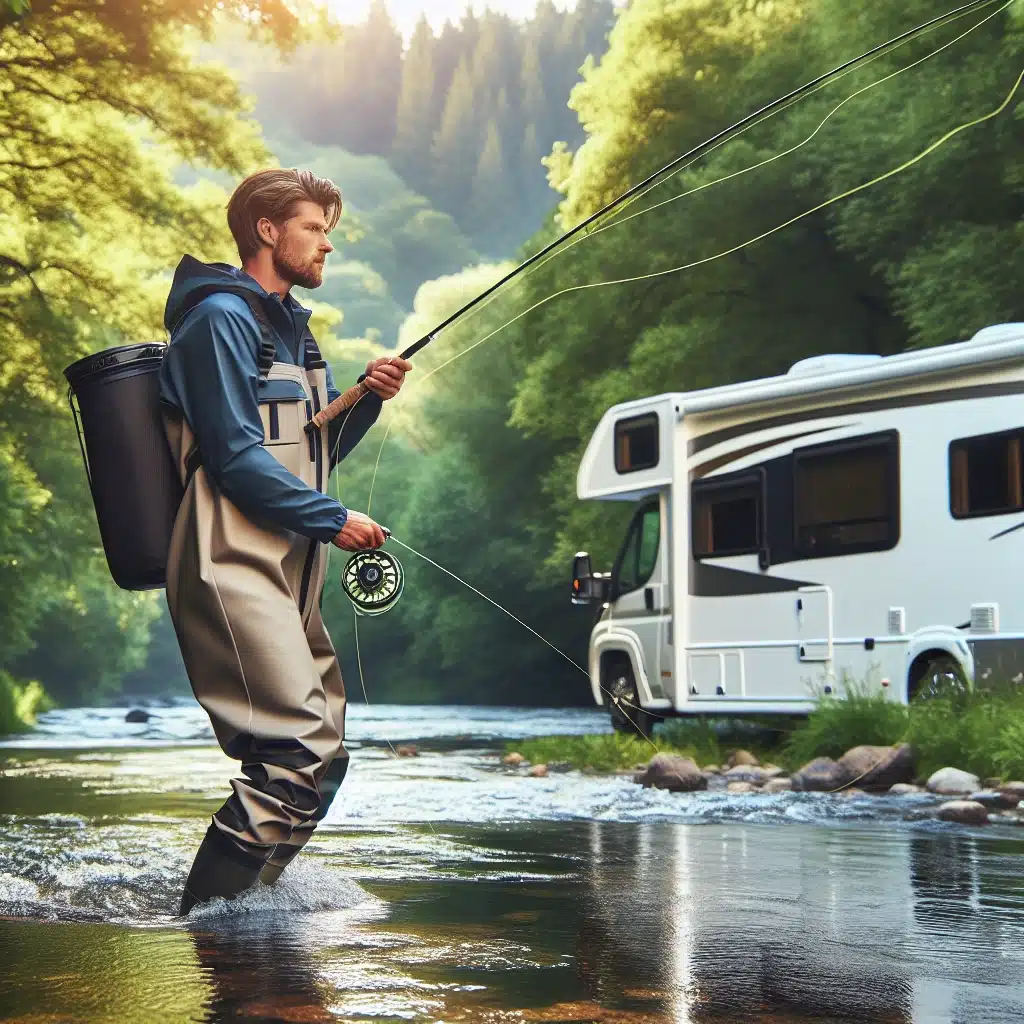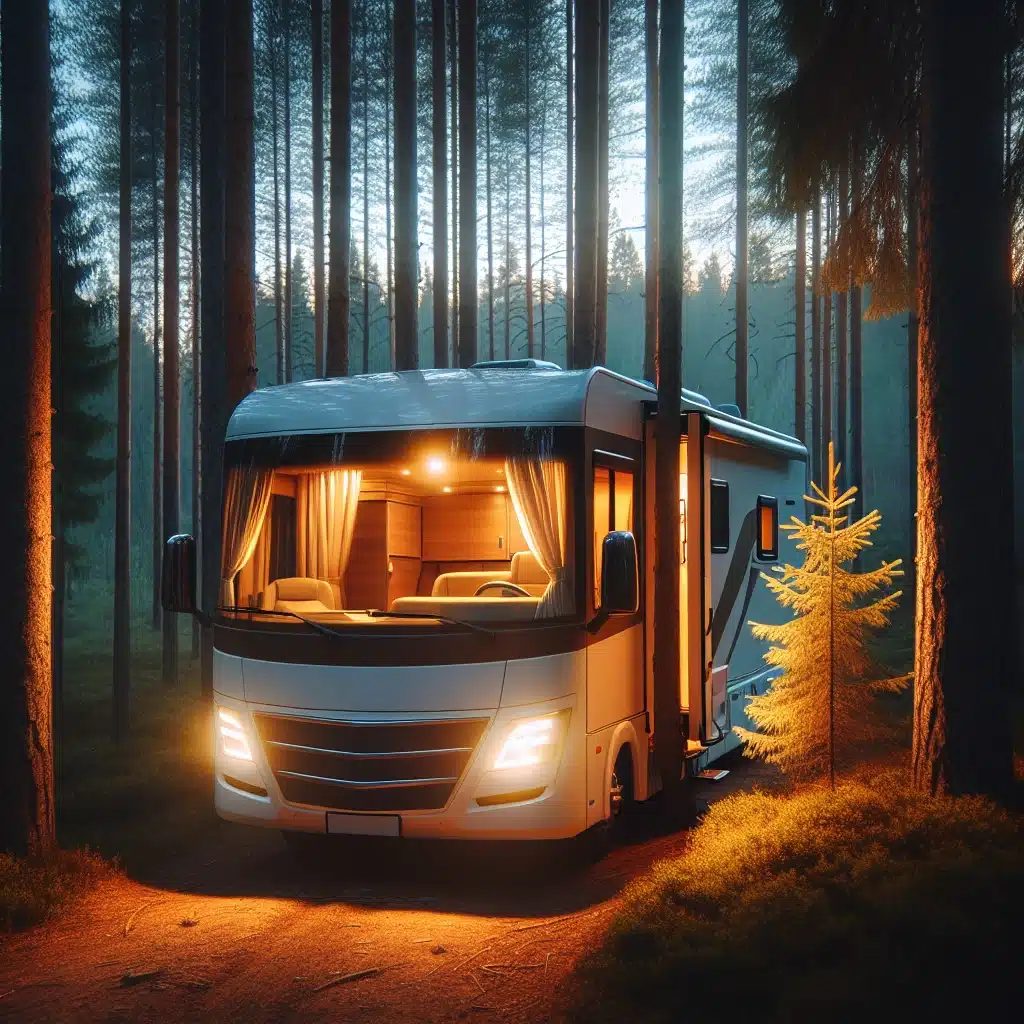Table of Contents

Imagine the freedom of camping in the wild, surrounded by nothing but nature. No power lines, no generators, just the peaceful serenity of the great outdoors. Now, picture doing all this with all the comforts of home at your fingertips, thanks to the power of the sun. Solar-powered wild boondocking camping is not just a dream; it’s a reality that’s within your reach.
With a solar-powered RV, you can explore off-grid locations without sacrificing the essentials like lighting, refrigeration, and device charging. You’re no longer tethered to campgrounds and their hookups. Instead, you’re free to roam where your spirit takes you, confident that the sun will provide the energy you need.
Embrace the Sun: Powering Your Wild Camping Adventures
The sun is your ally in the quest for the ultimate off-grid experience. By harnessing solar power, you can keep your RV’s batteries charged and your adventures going. Whether you’re parked in a desert landscape or nestled in a mountain retreat, solar panels convert sunlight into usable electricity, giving you the power to live comfortably, no matter where you are.
Key Takeaways: Simplifying Solar for the Road
- Freedom to camp anywhere with solar power as your reliable energy source.
- Understanding solar basics is key to a successful off-grid setup.
- Proper planning ensures your energy needs are met, and your adventures are uninterrupted.
- Knowing your RV’s power consumption is crucial for sizing your solar system.
- Components of a solar power system work together to keep you charged and ready.
Understanding Solar Power Basics for Boondocking
Before diving into the world of solar power, it’s important to grasp a few fundamentals. Solar power systems convert sunlight into electricity, which is then stored in batteries for use anytime. The heart of this system is the solar panel, which collects solar energy and starts the conversion process.
How Solar Energy Keeps You Charged Off-Grid
Solar energy is abundant and renewable. When you’re off-grid, solar panels on your RV’s roof capture sunlight and transform it into electrical power. This power is stored in your batteries and used to run your lights, fridge, and other essentials. It’s a silent, clean, and efficient way to keep your RV powered up without a generator’s noise or fumes.
Components of a Solar Power System for RVs
A solar power system for an RV typically includes solar panels, a charge controller, batteries, and an inverter. Each part plays a critical role:
- Solar Panels: Capture sunlight and convert it into electricity.
- Charge Controller: Regulates the voltage from the panels to the batteries, preventing overcharging.
- Batteries: Store the electricity for use when the sun isn’t shining.
- Inverter: Converts the stored DC power into AC power, which is what most of your appliances use.

Planning Your Solar Setup
Every RV and every camper’s energy needs are unique. To ensure your solar setup meets your needs, you must first understand your energy consumption. Start by making a list of all the electrical devices you use in your RV and how much power they consume. This will help you determine the size and number of solar panels and batteries you’ll need.
Calculating Your Energy Needs
Calculating your energy needs is simpler than it sounds. Start by listing all your electrical devices and the watts they use per hour. Multiply that by the number of hours you use them each day to get your daily watt-hour total. Remember to factor in everything from lights and fans to TVs and microwaves.
Example: If your lights use 40 watts and you use them for 5 hours a day, that’s 200 watt-hours per day just for lighting.
Once you have your daily watt-hour total, you’ll know how much energy your solar system needs to generate and store. This is the foundation for a solar setup that will keep your adventures bright, your food cold, and your devices charged, no matter where you park your RV.
Choosing the Right Solar Panels
Not all solar panels are created equal. The type and size of solar panels you choose should match your energy needs and the space available on your RV’s roof. There are two main types of solar panels: monocrystalline and polycrystalline. Monocrystalline panels are more efficient and require less space, but they’re also more expensive. Polycrystalline panels are more affordable but slightly less efficient.
Consider the climate you’ll be camping in as well. If you’re heading to areas with lots of sunshine, you might not need as many panels. But if you’re planning to camp in places with less sunlight, you’ll want more panels to capture as much energy as possible.
Lastly, think about the future. If you plan to add more electrical devices to your RV, it might be wise to install more panels than you currently need. This forward-thinking approach ensures you won’t have to redo your setup down the line.
Battery Banks – Your Energy Reservoir
Your battery bank is where all the energy your solar panels collect is stored. It’s your off-grid power supply when the sun goes down or on cloudy days. The size of your battery bank should be based on your calculated energy needs, with a little extra for peace of mind.
There are several types of batteries to choose from, including lead-acid, AGM, and lithium. Lithium batteries are the lightest and last the longest, but they’re also the most expensive. Lead-acid batteries are more budget-friendly but require regular maintenance and have a shorter lifespan.
Remember, the more storage capacity you have, the longer you can stay off-grid. But more batteries mean more weight and more space taken up in your RV, so it’s about finding the right balance for your travels.
Installing Your Solar Array
Once you’ve got all your components, it’s time to install your solar array. This is a critical step that can impact the efficiency and safety of your entire system. If you’re not comfortable with DIY electrical work, it’s best to hire a professional. But if you’re handy and ready to tackle the project, let’s walk through the basics.
Step-by-Step Installation Guide
- Plan Your Layout: Before you drill any holes, lay out your panels on the RV roof to find the optimal position. Keep in mind the path of the sun and any obstacles like air conditioning units or vents.
- Mount the Panels: Secure the mounting brackets to your RV roof, making sure to seal any holes to prevent leaks. Then, attach the solar panels to the brackets.
- Wire the Panels: Connect the solar panels to the charge controller using the appropriate gauge of wire. Ensure all connections are tight and secure.
- Install the Charge Controller: The charge controller should be placed in a convenient location inside your RV, close to the batteries but in a well-ventilated area.
- Connect the Batteries: Wire the charge controller to your battery bank, again using the correct gauge wire. Make sure the batteries are safely secured in place.
- Set Up the Inverter: If you’re using an inverter, connect it to your battery bank. This will convert the DC electricity stored in the batteries into AC power for your appliances.
- Test Your System: Once everything is connected, test your system to ensure it’s working correctly. Check all connections and monitor the charge controller to see that it’s charging the batteries as expected.
Installing a solar array is a big job, but with careful planning and attention to detail, you can do it. And once it’s done, the freedom it brings is well worth the effort.
Maintenance Tips to Maximize Life Span and Efficiency
- Regularly clean your solar panels to remove dirt, leaves, and other debris that can block sunlight.
- Check all electrical connections periodically to ensure they’re tight and free from corrosion.
- Monitor your battery levels and keep them charged to avoid depleting them, which can shorten their lifespan.
- Inspect your system after any severe weather to ensure everything is still securely attached and functioning properly.
- Keep an eye on your charge controller’s readouts to catch any potential issues early.
Proper maintenance not only extends the life of your solar power system but also ensures it runs at peak efficiency. A well-maintained system will provide more reliable power and save you money in the long run.

Best Practices While Boondocking with Solar Power
Boondocking with solar power is all about balance. You’re balancing the power you generate with the power you consume. To do this effectively, there are some best practices you should follow.
Optimizing Solar Panel Placement for Maximum Sun Exposure
The position of your solar panels can make a huge difference in how much energy they produce. Always aim to park your RV so the panels get maximum sun exposure. This might mean parking with the largest side of your RV facing south in the Northern Hemisphere, where the sun tracks across the southern sky.
Also, try to avoid parking in the shade or under trees where possible. While it might be cooler, it will reduce the amount of sunlight hitting your panels. If you’re staying in one spot for a while, consider using tilt mounts to angle the panels towards the sun as it moves across the sky.
By following these steps and maintaining your system, you’ll be well on your way to enjoying the freedom and independence that solar-powered wild boondocking camping has to offer.
Power Management – Making the Most of Your Amp Hours
Managing your power is crucial when you’re relying on solar energy. Think of your stored power as a water tank; every appliance you use is like opening a tap. If you open too many taps at once, or for too long, you’ll drain your tank. The key is to use only what you need and to replenish it as you go.
- Turn off lights and appliances when they’re not in use.
- Charge devices during the day when your panels are generating the most power.
- Use energy during peak sun hours to minimize battery drain.
- Invest in a good monitoring system to keep track of your power consumption.
- Consider upgrading to LED lighting, which uses less power than traditional bulbs.
By being mindful of your energy usage and making small adjustments, you can extend your amp hours and enjoy more time off-grid. It’s all about finding that sweet spot where your energy generation and usage are in harmony.
Must-Have Solar Gadgets and Gear for Boondocking
Equipping your RV with the right gadgets and gear can make your solar boondocking experience smoother and more enjoyable. From essential tools that help you monitor your system to accessories that boost your comfort, here’s what you should consider packing.
Solar Chargers for Your Devices
Keep your smartphones, tablets, and other USB devices charged with portable solar chargers. These handy gadgets come in various sizes and capacities, perfect for when you’re away from your RV on a hike or simply lounging outside.
- Folding solar USB chargers for easy storage and transport.
- Solar-powered power banks for on-the-go charging.
- Weather-resistant features for durability in the great outdoors.
With solar chargers, you’ll have the convenience of power wherever you go, ensuring you’re always connected when you need to be.
Energy-Efficient Appliances for Solar-Powered RVs
Maximizing your solar power means choosing appliances that do more with less. Energy-efficient appliances draw less power, which means your solar system can support more of your lifestyle needs.
- Propane or solar-powered refrigerators that keep your food fresh with minimal energy use.
- Induction cooktops that cook food quickly and efficiently.
- High-efficiency air conditioners and fans to keep you cool without draining your batteries.
By investing in energy-efficient appliances, you’ll not only save power but also reduce the strain on your solar system, extending its lifespan and performance.
Innovative Solar Tools that Enhance Off-Grid Living
Technology is constantly evolving, and there are some innovative tools out there that can take your solar boondocking to the next level.
- Solar ovens that let you bake, roast, and steam using just the power of the sun.
- Portable solar lighting systems for illuminating your campsite without cables or generators.
- Solar water heaters for hot showers without the need for gas or electricity.
These tools not only make off-grid living more comfortable but also help you maintain a smaller ecological footprint, keeping the great outdoors pristine for future adventurers.

Real-World Tips from Seasoned Solar Boondockers
There’s no substitute for experience, and those who’ve spent time boondocking with solar power have invaluable insights to share. Here are some real-world tips from those who’ve been where you’re headed.
Hidden Spots and Best Kept Secrets
Seasoned boondockers know that some of the best spots are the ones you won’t find in guidebooks. These hidden gems are often off the beaten path, offering peace, solitude, and unspoiled nature. While these locations are closely guarded secrets, here’s how you can find your own hidden gems:
- Use apps and websites dedicated to off-grid camping to uncover lesser-known locations.
- Connect with fellow boondockers online or in person to exchange tips on great spots.
- Look for public lands, like those managed by the Bureau of Land Management (BLM), where dispersed camping is often allowed.
- Always leave a spot cleaner than you found it to preserve its beauty for the next visitor.
Discovering your own secret boondocking spot can be one of the most rewarding experiences. Just remember to respect the land and keep the location as pristine as you found it.
By following these tips and equipping yourself with the right gear, you’ll be well-prepared to embrace the solar-powered boondocking lifestyle. Remember, the key to success is preparation, conservation, and a respect for nature that ensures these wild spaces remain untouched for generations to come.
Solar Boondocking Etiquette – Leaving No Trace
As we venture into the wild, it’s our duty to preserve the natural beauty we come to enjoy. Solar boondocking etiquette is rooted in the Leave No Trace principles. These guidelines help us minimize our impact and keep the great outdoors great for everyone.
- Dispose of waste properly by packing out all trash, leftover food, and litter.
- Use eco-friendly products to avoid introducing pollutants into the environment.
- Respect wildlife by observing from a distance and never feeding animals.
- Be considerate of other visitors by keeping noise levels down and giving them space.
- Leave what you find, taking only pictures and leaving only footprints.
Adhering to these practices ensures that our solar boondocking adventures are sustainable and that we’re doing our part to protect the planet.
Navigating Challenges in Solar-Powered Camping
While solar power offers freedom and self-sufficiency, it’s not without its challenges. Being prepared for these hurdles will help you enjoy a smooth and stress-free off-grid experience.
Dealing with Weather-Related Solar Setbacks
Weather can be unpredictable, and overcast skies or extended rainy periods can limit your solar power generation. Here’s how to manage these setbacks: Your Ultimate Guide to Boondocking.
- Have a backup power plan, such as a generator or extra battery storage, for when solar power is insufficient.
- Monitor weather forecasts to plan your energy usage around expected sunny days.
- Invest in high-efficiency solar panels that can capture more light on cloudy days.
- Adjust your energy consumption by prioritizing essential power needs during low-sunlight periods.
Being proactive and adaptable with your power management strategies will help you overcome weather-related challenges.
Safety Precautions and Emergency Planning
Off-grid camping means being far from help, so safety must be a top priority. Here are some precautions and emergency planning tips:
- Always let someone know your travel plans and expected return date.
- Keep a well-stocked first aid kit and know how to use it.
- Carry a reliable form of communication, such as a satellite phone or emergency beacon.
- Learn basic repairs for your solar system and carry necessary tools and spare parts.
- Have an evacuation plan in case of severe weather or other emergencies.
Preparation is key to ensuring you can handle unexpected situations and stay safe while enjoying the freedom of solar boondocking.
Frequently Asked Questions
How do I get started with solar power for my RV?
Starting with solar power for your RV is a rewarding process. Begin by assessing your energy needs based on the appliances you use and how often you use them. Next, research and select the right components—solar panels, charge controller, batteries, and inverter—that fit your energy requirements and budget. Consider consulting with a solar expert or an experienced RV solar system installer to ensure your setup is correctly sized and installed.
Can I go completely off-grid with solar power?
Yes, you can go completely off-grid with solar power, but it requires careful planning and investment. Your solar power system must be robust enough to meet all your energy needs, and you should have a backup plan for extended periods of bad weather. Additionally, you’ll need to practice energy conservation and efficient power management to make the most of your solar setup.
What maintenance is required for solar-powered systems?
Maintaining your solar-powered system is crucial for its longevity and efficiency. The good news is, it’s not overly complicated. Here’s what you need to do:
Keep your solar panels clean. Dust, leaves, and bird droppings can block sunlight and reduce efficiency. A simple wash with water and a soft brush can do the trick.
– Check your battery water levels if you’re using lead-acid batteries. Top them up with distilled water as needed.
– Inspect all cables and connections. Look for signs of wear, and ensure connections are tight to prevent energy loss.
– Monitor your system’s performance. Regularly check the charge controller and inverter for any error messages or alerts.
– Schedule an annual professional inspection to ensure everything is functioning correctly and safely.
With regular maintenance, you can catch small issues before they turn into big problems, keeping your system running smoothly for years to come.
How long do solar panels last?
Solar panels are built to last. Most manufacturers offer a 25 to 30-year warranty, and many panels continue to generate power well beyond that. While they do degrade slightly in efficiency each year, it’s typically only about 0.5% to 1%. So, after 25 years, your panels should still be operating at around 75-85% of their original capacity. That’s a solid return on investment for any boondocker looking to harness the sun’s power.
Can solar power systems provide enough energy for air conditioning and heating?
This is one of the most common questions about solar power for RVs. The answer is yes, but with some caveats. Air conditioning and heating are among the most power-hungry appliances in an RV. To run them solely on solar power, you’ll need a large solar array and battery bank, which can be costly and take up significant space.
However, there are ways to make it work:
– Use energy-efficient air conditioning units and consider supplementing with fans to reduce the load.
– For heating, use a diesel or propane heater to conserve electrical power.
– Insulate your RV well to minimize the need for heating and cooling.
– Plan your travels to take advantage of milder climates where possible.
With the right setup and some strategic planning, you can enjoy the comforts of climate control in your solar-powered RV.
As we wrap up this ultimate guide to solar-powered wild boondocking camping, let’s remember that the journey to energy independence is as rewarding as the destinations we explore. Solar power offers a sustainable and quiet way to enjoy the wild, and with the right setup, you can turn any spot off the beaten path into a cozy, eco-friendly home away from home.
Whether you’re a weekend warrior or a full-time nomad, the sun is your constant companion, fueling your adventures and keeping you connected to the world. Embrace the power of solar and join the growing community of RVers who’ve discovered the joy of untethered, environmentally-conscious travel. Here’s to clear skies and full batteries on all your boondocking adventures!
- Boondocking RVs: Flexible Solar Solutions – 3 March 2024
- Renewable Energy Tips for Full-Time Boondocking RVers – 2 March 2024
- Boondocking Solar Power Systems: Sizing Options & Solutions for Motorhomes – 1 March 2024
